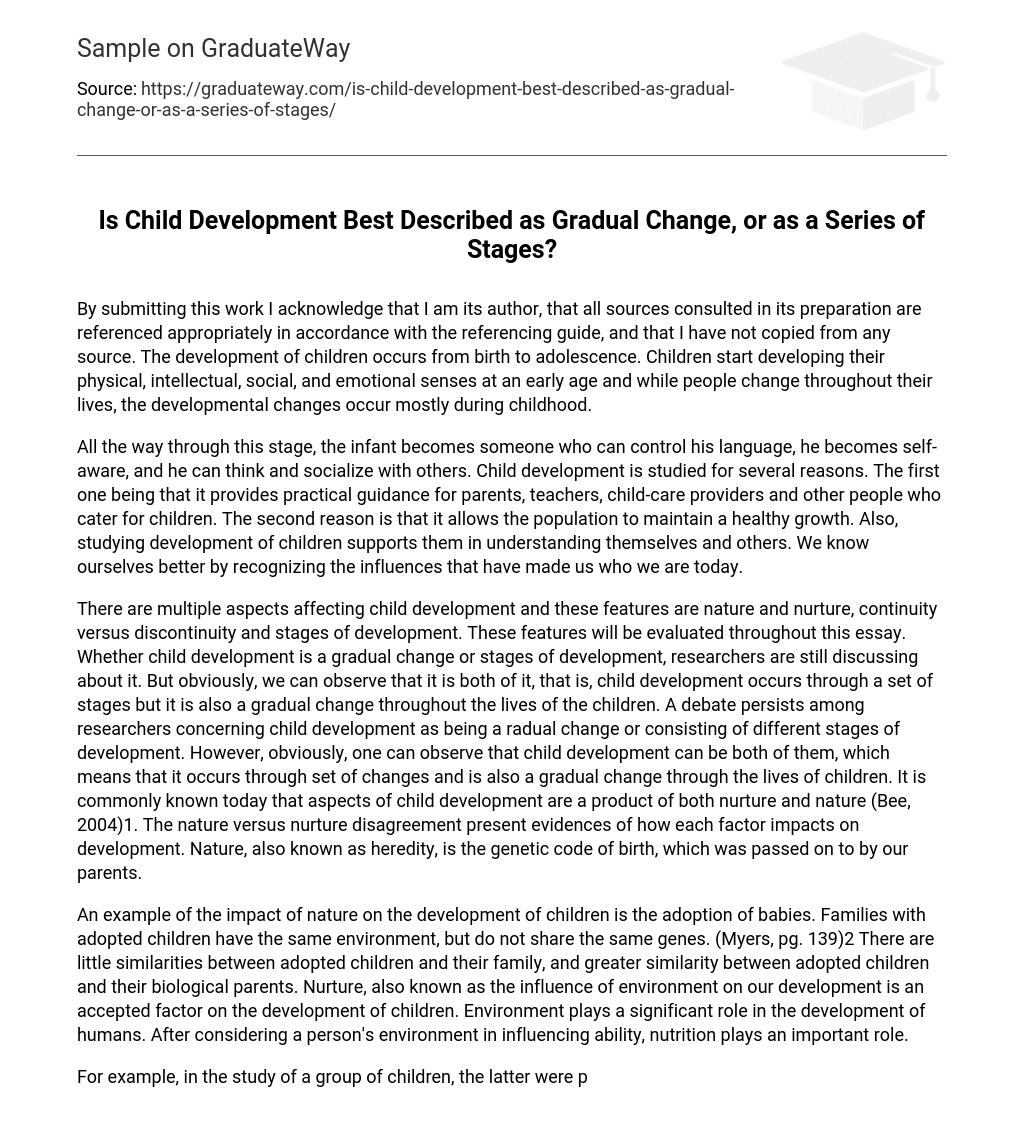By submitting this work, I affirm that I am the writer and have correctly cited all consulted sources as per the referencing guide. Moreover, I verify that no content has been plagiarized. Childhood development covers physical, intellectual, social, and emotional growth from birth to adolescence. While changes happen throughout a person’s life, childhood is when the most significant developmental changes take place.
At this stage, infants develop the abilities to control their speech, become self-aware, and engage in cognitive and social interactions. The field of child development has various goals: offering practical guidance for parents, educators, and caregivers; promoting healthy development within society; and improving understanding of oneself and others by studying children’s advancements. This allows us to enhance our awareness of ourselves by recognizing the influences that have shaped who we are today.
This essay will explore various factors that affect child development, including nature and nurture, continuity versus discontinuity, and stages of development. The ongoing debate among researchers revolves around whether child development is a gradual change or occurs in distinct stages. However, it is apparent that child development involves both stages and gradual changes throughout a child’s life.
Despite the ongoing discussion among researchers regarding whether child development is a gradual change or occurs in stages, it is evident that it encompasses both fixed changes and gradual progression. It is widely accepted that child development is influenced by both nature and nurture (Bee, 2004). The debate between nature and nurture provides evidence of how each factor impacts development. Nature refers to the genetic code inherited from our parents and plays a significant role in shaping child development.
According to Myers (pg. 139), nature has a significant impact on the development of children, as seen in adopted infants who grow up in different environments from their biological parents but still exhibit similarities with them. On the other hand, there is a stronger resemblance between adopted children and their biological parents than with their adoptive families. The influence of nurture, or environmental factors, on children’s development is widely recognized and both one’s surroundings and nutrition play crucial roles in shaping ability.
A study was conducted on a group of children who took vitamins and mineral supplements for eight months. Following the treatment, these children had to undergo intelligence tests. The findings indicated that the supplemented group achieved higher scores in comparison to a group that did not receive the supplements (“Nature vs. Nurture”, 2001)3, implying that the environment has an impact on individuals’ intellectual abilities. Yet, when considering the gradual changes and developmental stages in children, it raises questions about nature versus nurture and prompts us to contemplate continuity and discontinuity.
Development progresses in two major ways: continuity and discontinuity. In the continuity process, children constantly develop skills, awareness, knowledge, and behaviors. On the other hand, discontinuity refers to development occurring at different stages and times. In this case, development cannot proceed without completing earlier stages, and a child may struggle to acquire specific skills. For example, if a child does not start babbling in the first stage, they may find it challenging to start talking later on.
Some theories of development suggest that changes in children’s skills as they get older are primarily a matter of quantity. Other theories propose a series of sequential stages in which skills emerge at specific points in development. One such theory is the Psychoanalytic theory, developed by Sigmund Freud in 1900. Freud emphasized the significance of the unconscious mind and childhood experiences. He suggested that development occurs through a series of psychosexual stages, during which the id’s pleasure-seeking energies become focused on different erogenous areas.
This energy, also referred to as libido, was defined as the driving force behind behavior. Erik Erikson (1963), a prominent theorist, expanded on Freud’s theory by emphasizing the conflicts that arise at various stages of development. However, unlike Freud, Erikson suggested that development occurs through gradual change. According to Erikson, our sense of ego identity is constantly evolving as we gain new experiences and knowledge through daily interactions with others. He also emphasized that abilities serve as motivators for behavior and achievements.
According to Erikson’s theory, each stage focuses on developing competence in a specific area of life. Successful handling of a stage leads to a sense of mastery, also known as ego strength or ego quality. In contrast, poor management of a stage results in feelings of failure. Jean Piaget proposed that children construct their understanding through interactions with the world, experiencing periods of rapid change followed by periods of stability as they progress through four cognitive stages: sensorimotor, preoperational, concrete operational, and formal operational. These stages span from birth to adulthood. When considering the ideas presented by these theorists, it becomes apparent that they have made significant contributions to our understanding of child development. Overall, child development involves both gradual change and distinct stages.
Piaget, Erikson, and Freud all argue for the superiority of their respective theories. However, upon closer inspection, it becomes evident that these theories are actually complementary and collectively offer a comprehensive comprehension of child development. Additionally, it is crucial to acknowledge the substantial impact of both nature and nurture on child development. Moreover, it is important to understand that growth does not follow a straight path; if children fail to sufficiently progress at each stage, moving on to the next level can prove challenging because they have not attained the necessary level for successful advancement. Consequently, this interruption impedes the continuity of their development.





